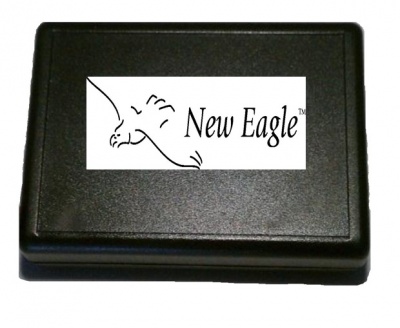Telematics
New Eagle Telematics Solutions
New Eagle has been developing a low-cost, MotoHawk compatibile telematics product line.
Our current telematics board is our standalone unit that can perform a multitude of functions from CAN data-aggregation and analytic processing to real-time vehicle monitoring through available Cell/Wi-fi networks. It can communicate desired parameter information to the base station in the form of raw CAN data, web browser interfaces and text/email alerts. Compatibility with MotoHawk development environment provides us a means of its smooth integration with your CAN bus systems.
Please contact sales for information.
CAN Based Data Logger
The logger utilizes standard SD cards for data storage making it easy to retrieve data for applications including Event Data Logging (EDR). This device is capable of logging at rates of 1ms, making it an ideal choice for any CAN bus environment. Built in key switch detection and keep-alive circuitry ensure clean shutdowns and proper file closures.

Features
- CAN data logging
- Easily log CAN bus data to an SD card
- Utilize configuration files to limit desired data or change CAN bus speed
- Data logging is limited only by the size of the SD card, right now 16GB cards are the largest supported.
- Real-time clock with battery backup providing date/time information for log files
- Firmware updates via SD Card
- Optional key switch detection
- Optional Configurable warning horn
- Status LED’s
- State of Health
- SD Card Presence and data logging
- Indicators for CAN Tx/Rx Traffic and Bus errors
- The log file is a text file format that lists all the CAN messages. This allows the user to import the data into excel or other programs.
FAQs
SD Cards
The data logger should be able to work with most SD cards. However, to help customers a selection of SD cards has been tested and verified to work. This list will be added to as more cards are tested. If you find a card that works well, let us know and we can test and add it to the list. The current approved SD cards are:
- Walgreens SD – Class 2 – 2GB
- SanDisk SD Card – Class 2 – 2GB
- SanDisk SDHC – Class 4 – 4GB
- SanDisk Ultra HCI – Class 6 – 4GB
- PNY HC – Class 10 – 8GB
- SanDisk Ultra HCII – Class 4 – 8GB
- SanDisk Extreme HD HCI – Class 10 – 8GB
- SanDisk Extreme SDHC – Class 10 – 16GB
SD Card Errors
Unfortunately, we cannot guarantee the approved SD cards will work as needed because not all SD Cards are built equally. From our experience, the above SD Cards are the most reliable.
Log File Name
The log file name needs to be LOGGER.MEC with all caps. Other names might load and work with the logger. However, the logger software might not pick up other names.
Auto Flush
A new auto flush feature has been added. This feature has the data logger back up the CAN information more often to the SD card. This means that data will be on the card if power is lost. If the option is not selected the SD card will back up, but not as often meaning data will be lost. The downside to the auto flush feature is that it lowers the performance of the data logger, so it cannot log as many messages.
Extending User Action Button
The digital input is used to extend the user action button. When the input the unit will act as if the user action has been pressed. This allows you to use the action button when the data logger is installed elsewhere in the system.
Voltage Spikes Above Operating Range
The unit is load dump protected up to 60v, though when the voltage rises above 33v the unit will shut down. Therefore during transients like these the unit will be non-operational and self-recover when the input voltage returns to within specification.
How to Log Data
Logging data for the unit is very easy and straight forward, and involves setting up a short configuration file. This just takes a couple lines for the header and then a list of all the CAN messages you want to monitor. There are a couple of advanced fault options, but those are easy to use as well. You delete all files on the SD card and load the configuration file so it is the only file on the card. Next insert the SD card into the unit. The unit then has 8 LEDs and an action button. The datasheet tells you what each LED means, they include if CAN messaging is active on the bus, if the unit is recording, is there a fault, etc. The action button allows you to pause the data reading and to signal events to place a marker to be looked at.
When you are done pull the card out and plug it into the computer. There is a simple text file with all the CAN messages listed. This text file is formatted so that it can be imported into almost any CAN analyzing software.
There is also a free GUI that allows the user to more easily create the configuration file. That tool can be downloaded below.
Configuration File Tool
New Eagle CANLogger Configuration File Program
Software Update
The file to update the Datalogger to version 1.021 can be downloaded here, Update File.
Datasheets
New Eagle CANLogger User Manual